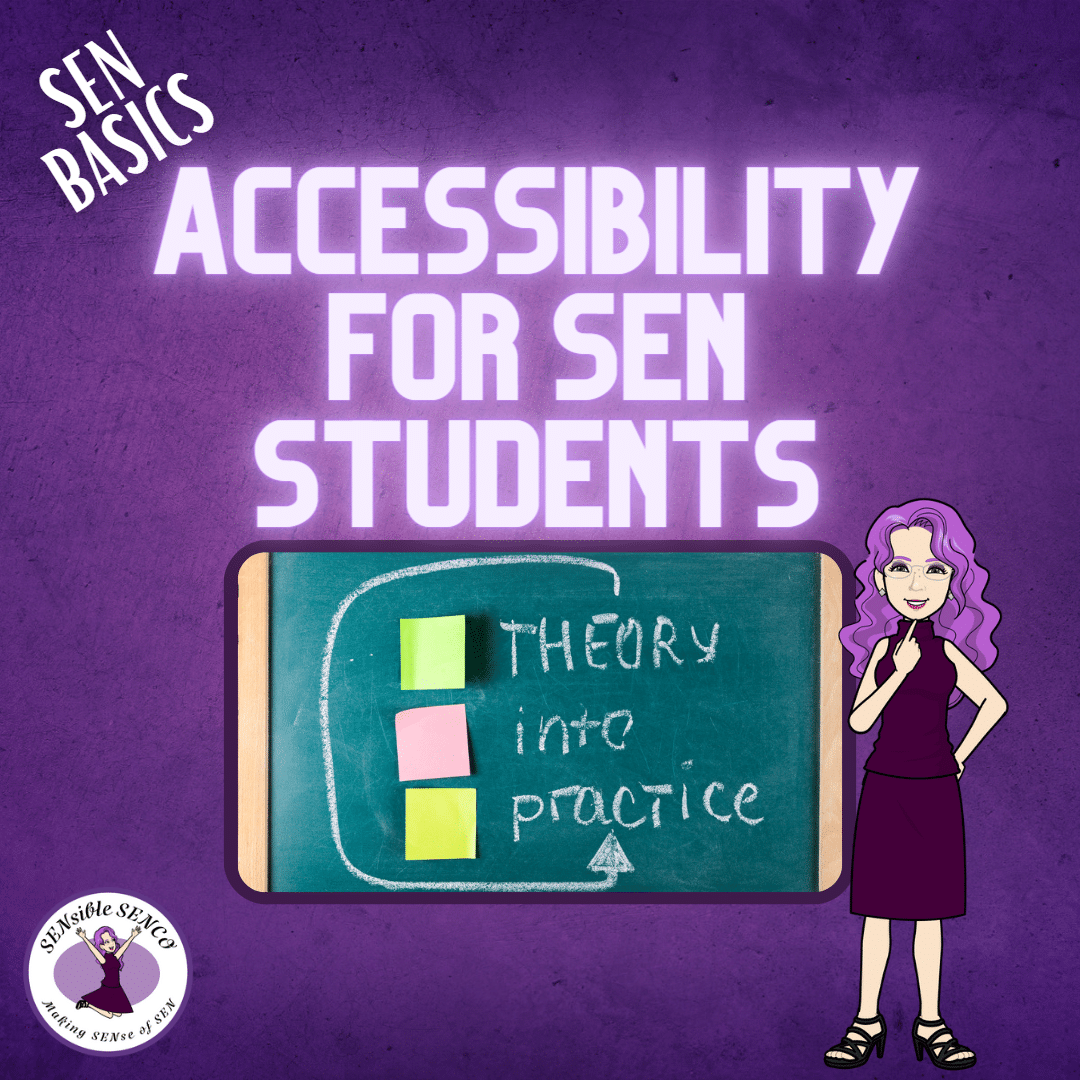Accessibility for SEN Students: Strategies and Tools for Supporting Access in the UK
Introduction
Understanding Special Educational Needs (SEN)
Inclusive Education and Mainstream Schools
Support Systems for SEN Students in Mainstream Schools
Strategies for Supporting SEN Students in the UK
1. Differentiated Instruction: Teachers employ a variety of teaching approaches and materials to cater to diverse learning needs within the classroom. This approach ensures that every student, including those with SEN, receives instruction at their level of understanding and can actively participate in the learning process.
2. Individual Education Plans (IEPs): IEPs are personalised plans developed for students with SEN. These plans outline specific learning goals, accommodations, and support strategies tailored to the individual student’s needs. IEPs promote a collaborative approach involving teachers, parents, and support professionals to ensure targeted support for each student.
3. Multi-Sensory Learning: This approach involves engaging multiple senses to enhance learning. For example, incorporating visual aids, auditory cues, and hands-on activities can help SEN students better comprehend and retain information.
4. Peer Support and Collaboration: Encouraging peer interactions and collaboration fosters an inclusive and supportive classroom environment. Peer support programs, group projects, and cooperative learning activities enable SEN students to learn from their peers and develop social skills alongside their academic growth.
5. Assistive Technology: Assistive technology tools play a vital role in supporting SEN students. These tools include screen readers, magnification software, speech-to-text software, and specialised apps designed to enhance accessibility and facilitate learning for students with different abilities. By integrating assistive technology into the learning environment, educators can bridge the accessibility gap and empower SEN students to participate fully in educational activities.
Tools and Technology for Enhancing Accessibility
1. Screen Readers: These software programs convert text on a computer screen into synthesised speech, enabling visually impaired students to access written content.
2. Speech-to-Text Software: This type of software allows students with writing difficulties to dictate their responses or assignments, which are then converted into text.
3. Magnification Tools: Magnification software enlarges on-screen text and images, making them easier to read for students with visual impairments or visual processing difficulties.
4. Alternative Input Devices: Specialised input devices such as adapted keyboards, switches, or joysticks can assist students with physical disabilities in navigating digital resources and interacting with computers.
5. Communication Aids: Augmentative and alternative communication (AAC) devices facilitate communication for students with speech or language impairments. These devices include picture-based communication boards, speech-generating devices, and software applications.
By utilising these tools and technologies, educators can create a more inclusive and accessible learning environment for SEN students, empowering them to overcome barriers and achieve their full potential.
Training and Professional Development for Teachers
Teacher training for supporting SEN students includes:
1. Understanding SEN: Teachers learn about different types of SEN, their characteristics, and the impact they may have on learning. This knowledge helps teachers identify and respond effectively to the needs of individual students.
2. Differentiated Instruction Strategies: Teachers learn strategies for adapting their teaching methods to accommodate diverse learning needs. They gain insights into creating inclusive lesson plans, providing individualised support, and fostering a supportive classroom environment.
3. Assistive Technology Integration: Teachers receive training on the effective integration of assistive technology tools into their teaching practices. They learn how to select appropriate tools, provide guidance to students in using them, and maximize their benefits in enhancing accessibility and learning outcomes.
4. Collaboration and Partnership: Teachers are encouraged to collaborate with special education professionals, support staff, and parents to develop comprehensive support plans for SEN students. They learn effective communication strategies and how to facilitate a collaborative approach to meet the unique needs of each student.
5. Reflective Practice: Teachers engage in reflective practice to continuously evaluate and improve their teaching methods for SEN students. They learn to assess the effectiveness of their strategies, make adjustments as needed, and seek ongoing professional development opportunities to stay updated on best practices.
By providing teachers with comprehensive training and professional development opportunities, the education system in the UK ensures that educators are well-equipped to support the diverse needs of SEN students and create inclusive learning environments.
Collaborative Approaches and Partnerships
1. Teachers and Support Staff: Collaboration between teachers and support staff, such as learning support assistants or inclusion coordinators, is essential for implementing individualised support plans and accommodating the needs of SEN students in the classroom.
2. Special Education Professionals: Special education professionals, including educational psychologists and speech and language therapists, provide specialised expertise and assessments to support the identification and intervention for SEN students. Collaborating with these professionals ensures comprehensive support for students with specific needs.
3. Parents and Caregivers: Parental involvement is vital in supporting the educational journey of SEN students. Collaboration with parents and caregivers helps educators gain valuable insights into the student’s strengths, challenges, and individualised support strategies. It also fosters a partnership in which parents and educators work together to create a consistent and supportive learning environment.
4. Community Organisations and Support Services: Collaborating with community organisations and support services, such as local disability support groups or assistive technology providers, can enhance the resources and support available to SEN students. These partnerships allow for access to specialised services, workshops, and resources that further promote inclusive education.
By fostering collaborative approaches and partnerships, the education system can create a network of support that addresses the multifaceted needs of SEN students, ensuring a comprehensive and inclusive educational experience.
Importance of Parental Involvement
1. Insight into the Child’s Needs: Parents have a deep understanding of their child’s strengths, weaknesses, and individual needs. This insight can be valuable for educators in tailoring support strategies and creating personalised learning plans.
2. Consistency and Continuity of Support: When parents and educators work collaboratively, it ensures consistency in the support provided to SEN students. Open communication and shared goals between parents and educators allow for a coordinated approach to meeting the student’s needs both at home and in school.
3. Advocacy and Empowerment: Parents are powerful advocates for their child’s educational rights and can actively contribute to creating an inclusive and accessible learning environment. Their involvement empowers both the student and the education system to prioritize the needs of SEN students.
4. Home-School Connection: Parental involvement strengthens the connection between home and school. It enables parents to reinforce learning at home, support homework completion, and engage in activities and discussions that extend the learning beyond the classroom. This home-school connection enhances the overall educational experience and promotes a sense of belonging and support for SEN students.
5. Emotional Support: Parental involvement provides emotional support to SEN students. When parents are actively engaged in their child’s education, it sends a message of care and support, boosting the student’s confidence and well-being.
The education system in the UK recognises the importance of parental involvement and encourages parents to actively participate in their child’s education. By fostering strong partnerships between parents and educators, SEN students receive comprehensive support that promotes their academic, social, and emotional growth.
Challenges and Considerations
1. Funding and Resources: Adequate funding and resources are essential to implement inclusive practices and provide necessary support to SEN students. Ensuring equitable access to assistive technology, specialised staff, and professional development opportunities requires a sustained commitment to investment.
2. Teacher Training and Capacity: Ongoing training and professional development for teachers are crucial to build their capacity in supporting SEN students effectively. Providing sufficient training opportunities and ensuring that all educators have the necessary skills and knowledge can be a challenge that requires continuous support.
3. Individualised Support: Every SEN student has unique needs, requiring individualised support plans. Developing and implementing personalised strategies for each student can be resource-intensive and requires collaboration among multiple stakeholders.
4. Inclusive Classroom Practices: Creating truly inclusive classrooms involves adapting teaching methods, materials, and assessments to accommodate diverse learning needs. Educators need support and guidance to implement inclusive practices effectively.
5. Awareness and Attitudes: Building awareness and fostering positive attitudes towards SEN students are essential for creating an inclusive and accepting learning environment. Addressing misconceptions, reducing stigma, and promoting empathy and understanding among students, teachers, and the wider community are ongoing challenges.
Addressing these challenges requires a collective effort from the education system, policymakers, educators, parents, and the wider community to ensure that SEN students receive the support and opportunities they need to thrive.
Best Practices and Success Stories
The Park School, Essex: The Park School in Essex has implemented a comprehensive inclusive education policy that embraces the principles of Universal Design for Learning (UDL). They have successfully created an inclusive environment by adopting flexible teaching approaches, providing personalised support, and promoting collaboration among students with diverse abilities. This approach has led to improved academic outcomes and increased student engagement.
The Ace Centre, Oxfordshire: The Ace Centre is a specialised organisation that provides support and expertise in augmentative and alternative communication (AAC) for SEN students. They work closely with schools, parents, and professionals to assess individual needs, provide training, and ensure the effective use of AAC devices and strategies. Through their intervention, many SEN students have gained the ability to communicate effectively and participate fully in educational activities.
Braidwood School, Birmingham: Braidwood School is a specialised school for deaf children in Birmingham. They have implemented innovative practices to support deaf students in their academic and social development. The school uses a combination of sign language, speech therapy, and assistive technology to facilitate communication and provide an inclusive learning environment. Graduates from Braidwood School have achieved remarkable success in their educational and professional pursuits.
The British Dyslexia Association: The British Dyslexia Association (BDA) is a prominent organisation that supports individuals with dyslexia and raises awareness about the condition. The BDA works with educational institutions to provide training for teachers, disseminate best practices, and develop dyslexia-friendly schools. Their efforts have led to increased understanding of dyslexia and the implementation of effective strategies to support dyslexic students throughout the UK.
The Autism Education Trust: The Autism Education Trust (AET) is a partnership between several autism-focused organizations in the UK. AET provides training and resources to educators to enhance their understanding of autism and develop inclusive practices. Their initiatives have resulted in improved educational experiences for autistic students, with increased support, reduced barriers, and better outcomes in terms of academic achievement and social integration.
These real-life examples demonstrate the positive impact of implementing inclusive practices, providing specialised support, and fostering collaborative partnerships in the education system. They serve as inspiring success stories and set benchmarks for promoting accessibility and supporting the needs of SEN students in the UK.
Conclusion
While challenges exist, the commitment to supporting SEN students is evident through the adoption of best practices, the provision of training and resources, and the cultivation of collaborative partnerships. By recognising the individual needs of SEN students, implementing inclusive strategies, and leveraging assistive technology, the education system in the UK is working towards creating a more accessible and inclusive learning environment.
Through the active involvement of parents and caregivers, the home-school connection is strengthened, providing consistent support and advocacy for SEN students. Ongoing efforts to raise awareness, address misconceptions, and promote positive attitudes towards SEN students contribute to a more inclusive society.
In conclusion, accessibility for SEN students in the UK is a multifaceted endeavour that requires the commitment and collaboration of various stakeholders. By embracing inclusive practices, providing targeted support, and fostering partnerships, the education system strives to create an environment where every SEN student can thrive and reach their full potential.
FAQs
SEN refers to Special Educational Needs, which encompass a range of learning difficulties or disabilities that require special support and accommodations to facilitate effective learning.
2. How are mainstream schools suitable for SEN students?
Mainstream schools in the UK are suitable for SEN students who have the cognitive abilities and adaptive skills to access the national curriculum and learning environment. These schools provide inclusive education, social interactions, and exposure to diverse learning experiences, benefiting the overall development of SEN students.
3. What are some examples of assistive technology for SEN students?
Assistive technology for SEN students includes screen readers, speech-to-text software, magnification tools, alternative input devices, and communication aids. These tools enhance accessibility and facilitate learning for students with different abilities.
4. How can teachers be trained to support learners with SEN?
Teachers can receive training on understanding SEN, differentiated instruction strategies, assistive technology integration, collaboration with support professionals, and reflective practice. Ongoing professional development opportunities ensure that teachers have the necessary skills to support learners with SEN effectively.
It is crucial to remember that promoting diversity and inclusion is an ongoing process that requires continuous effort and collaboration. By working together, educators, parents, and the community can create a supportive and inclusive educational ecosystem where every student feels valued, respected, and empowered to succeed.
If you have any further questions or need additional information, please feel free to comment below.
Together, let’s continue to promote diversity, inclusion, and equity in education, making a positive difference in the lives of students and society as a whole.
ents.

Abigail Hawkins FCCT
Director of SENDCO Solutions




